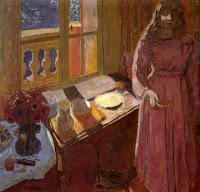Mitsouko and Rouge oil on canvas 92x76cm
This painting which I still have at home( as I am always making small adjustments here and there), seems to be an occurring theme of mine. A female figure looking in a mirror at her dressing table. It’s just something that hits a note of recognition and empathy within me, and spending some time thinking about its source; of course I do know its origins. I think we all have role models and heros as young children; adults in our lives that influence us, both negatively and positively. I feel that we are all very selective in what we want to extrapolate from experiences, and I have certainly done that in my life. I used to watch captivated as my gran would” put on her face” every morning in front of her 3 sided dressing table mirror, with her silver backed hair brushes, pots of rouge and face powder. Dabs of foundation were applied with a formulaic dexterity; pouting to receive the strong application of colour which she then carefully toned down by positioning a tissue between her rubied lips. She used to let us sit there for a while( or maybe I just sneaked back when she was otherwise occupied, selective memory again), excitedly opening perfumed pots and using the fairy tale hair brushes. But what a shock to look in that 3-sided mirror, and to gaze at the strange side profile that was undeniably me, but not a me I had seen before, such visual adventures and discoveries that have imprinted and remained with me still.
Another very influential women of my past was an aunt, she was so bohemian and cool. Her house smelt of rush matting, garlicy continental cooking and Guerlain’s Mitsouko perfume. I re-lived these childhood memories of visiting my cousin’s house, by buying a bottle of this perfume about 15 years ago. And it completely delivered on every count, I so love this perfume. Mitsouko and Rouge is a tribute painting to all those strong actualized women that somehow managed to create their own very personal imprint by changing the atmosphere around them, simply by celebrating and delighting in their womanhood.

















